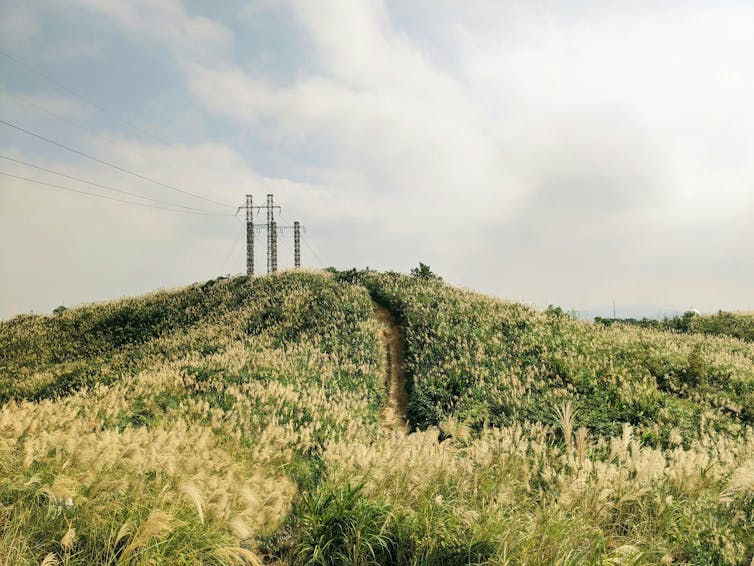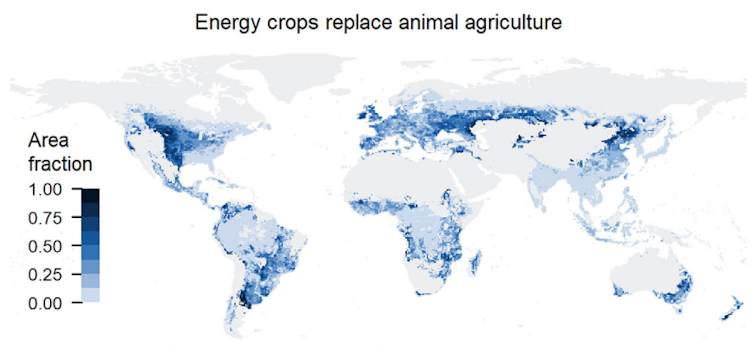
Oscar Rueda, Leiden University and Laura Scherer, Leiden University
A radical reduction in the amount of meat, dairy and other products sourced from animals is possible in the coming decades, as people turn to an increasing variety of alternatives. This would unlock vast amounts of land currently used to rear animals and to grow crops that feed them.
We recently published research that considered what might happen if demand for animal products really did decrease and the newly released agricultural land was instead used to grow crops for renewable energy and carbon removal. In short, we found the potential benefits are huge.
Replacing animal-sourced products at a large scale may seem unthinkable at present. But new alternatives, such as plant-based mock meat or lab-grown meat, could closely match the real thing in taste and texture. With time, they may even beat them in costs.
For now, replacing animal-sourced products often means paying a premium and sacrificing taste. It is niche groups concerned about their health, the environment, or animal welfare who are willing to pay. But in the future, a similar experience at a lower cost may make these alternatives go mainstream.
Unlocking the potential of an old climate friend and foe
All this would free up huge amounts of land and water, since there would be less need for fields full of cows, chickens or pigs, or for crops grown to feed them. In our research, we estimated that fully replacing animal-sourced products would release more than 60% of the world’s agricultural land. Other researchers think as much as 75% might be released.
While a full replacement is unlikely, studies by various consultancies suggest a more modest amount of meat might be phased out, perhaps 10%-30% by 2030 or 30%-70% by 2050. But even these would free up extensive agricultural areas.
What would we do with all that land? Simply leaving it alone might be the most sensible solution in many cases. This way, the land can gradually return to its natural state, storing carbon, regulating the climate and providing habitat for wild animals.
But we could also use that land to produce energy while removing carbon dioxide from the atmosphere, through a process known as bioenergy with carbon capture and storage (Beccs).
Beccs has gone in and out of fashion
Bioenergy crops, grown on newly freed agricultural land, would capture CO₂ from the atmosphere and store it as carbon (plants and animals are mostly made of water and carbon). The crops would be used as fuel to produce energy, which would turn the carbon back into CO₂.

Angela Lo / unsplash, CC BY-SA
However, instead of simply releasing it back to the atmosphere (as conventional bioenergy systems do today), the CO₂ would be captured and permanently stored deep underground. This way, the system would generate a net removal of CO₂ from the atmosphere in many cases.
After Beccs was first proposed over two decades ago, many scientists embraced the idea and included it in plans to address climate change. In recent years, however, they have increasingly advised against it.
These scientists say that growing more crops would mean converting more forests and other natural ecosystems into agricultural land, while the water used to irrigate the crops would mean less left for people and ecosystems. And they point out that competition for agricultural land with food crops could threaten food security.
Beccs could overcome its main challenges
In our research, we have estimated how a move away from animal-sourced products could help overcome those challenges and unlock substantial potential for Beccs. By using agricultural land that is no longer needed, Beccs would avoid any need for agricultural expansion or water stress, and it would mean enough food could still be produced for everyone.

Rueda et al (2024) / One Earth, CC BY-SA
If 50% of animal products were replaced by 2050, that could release enough land for Beccs to generate as much electricity as coal power does today (about a third of the global total), while removing almost the same amount of carbon as coal currently emits. Alternatively, Beccs could produce around half the projected global hydrogen demand in 2050, with a similar amount of “negative emissions”.
We estimated these negative emissions by adding up how much carbon Beccs would take from the atmosphere and store underground, minus the emissions from growing the bioenergy crops and converting them into energy. And we then deducted the carbon that would have been stored by regrowing plants if we left the released agricultural land alone and did nothing.
We also found that many countries, including the biggest polluters, could store all the captured CO₂ deep underground within their territories.
All this sounds highly attractive. However, we cannot take for granted that the potential of Beccs will actually be harnessed.
Its sustainability challenges might be tackled by people eating less meat, but various technical, social, and political challenges may still hinder its adoption. We also still don’t know exactly how plant-based and cultivated meats will be adopted and what their impact will be.
The good news is that the plant-based alternatives that are currently available already offer a more certain potential to release vast land and water in the short term. It is up to nations and individuals to make the most of it.![]()
Oscar Rueda, Doctoral Researcher, Institute of Environmental Sciences, Leiden University and Laura Scherer, Assistant Professor, Institute of Environmental Sciences, Leiden University
This article is republished from The Conversation under a Creative Commons license. Read the original article.







